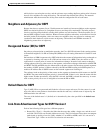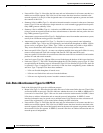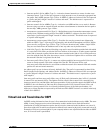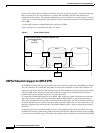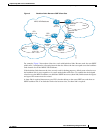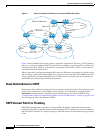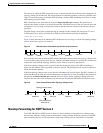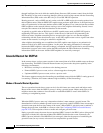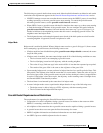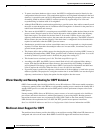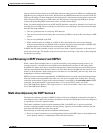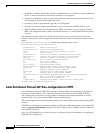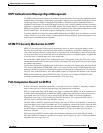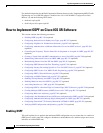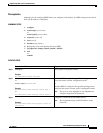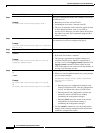
Implementing OSPF on Cisco IOS XR Software
Information About Implementing OSPF on Cisco IOS XR Software
RC-189
Cisco IOS XR Routing Configuration Guide
OL-14356-01
The following are general details about restart mode. More detailed information on behavior and certain
restrictions and requirements appears in the Graceful Restart Requirements and Restrictions section.
• If OSPFv3 attempts a restart too soon after the most recent restart, the OSPFv3 process is most likely
crashing repeatedly, so the new graceful restart stops running. To control the period between
allowable graceful restarts, use the graceful-restart interval command.
• When OSFPv3 starts a graceful restart with the first interface that comes up, a timer starts running
to limit the duration (or lifetime) of the graceful restart. You can configure this period with the
graceful-restart lifetime command. On each interface that comes up, a grace LSA (type 11) is
flooded to indicate to the neighboring routers that this router is attempting graceful restart. The
neighbors enter into helper mode.
• The designated router and backup designated router check of the hello packet received from the
restarting neighbor is bypassed, because it might not be valid.
Helper Mode
Helper mode is enabled by default. When a (helper) router receives a grace LSA (type 11) from a router
that is attempting a graceful restart, the following events occur:
• If helper mode has been disabled through the graceful-restart helper disable command, the router
drops the LSA packet.
• If helper mode is enabled, the router enters helper mode if all of the following conditions are met:
–
The local router itself is not attempting a graceful restart.
–
The local (helping) router has full adjacency with the sending neighbor.
–
The value of lsage (link state age) in the received LSA is less than the requested grace period.
–
The sender of the grace LSA is the same as the originator of the grace LSA.
• Upon entering helper mode, a router performs its helper function for a specific period of time. This
time period is the lifetime value from the router that is in restart mode—minus the value of lsage in
the received grace LSA. If the graceful restart succeeds in time, the helper’s timer is stopped before
it expires. If the helper’s timer does expire, the adjacency to the restarting router is brought down,
and normal OSPFv3 functionality resumes.
• The dead timer is not honored by the router that is in helper mode.
• A router in helper mode ceases to perform the helper function in any of the following cases:
–
The helper router is able to bring up a FULL adjacency with the restarting router.
–
The local timer for the helper function expires.
Graceful Restart Requirements and Restrictions
The requirements for supporting the Graceful Restart feature include:
• Cooperation of a router’s neighbors during a graceful restart. In relation to the router on which
OSPFv3 is restarting, each router is called a helper.
• All neighbors of the router that does a graceful restart must be capable of doing a graceful restart.
• A graceful restart does not occur upon the first-time startup of a router.
• OSPFv3 neighbor information and database information are not check-pointed.
• An OSPFv3 process rebuilds adjacencies after it restarts.



